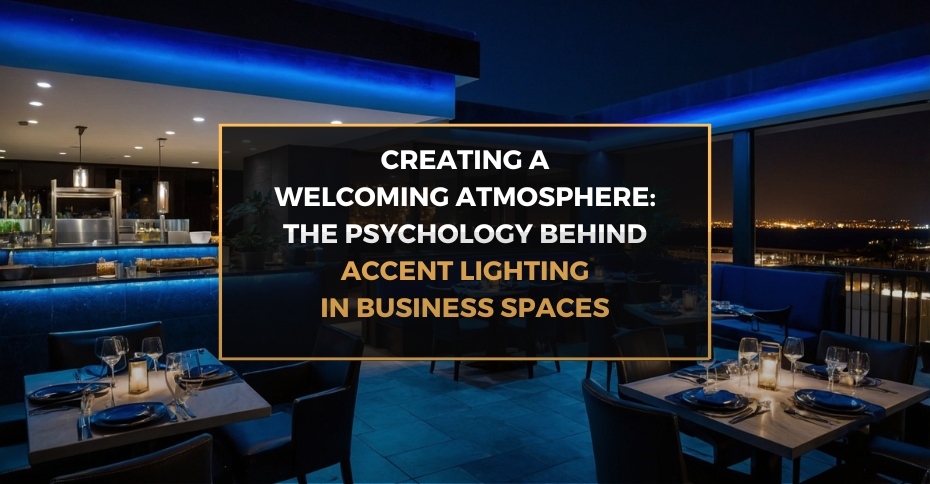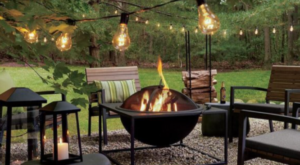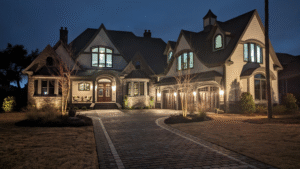Outdoor accent lighting in business spaces plays a crucial role in shaping perceptions and enhancing experiences. The use of lighting extends beyond mere functionality; it taps into psychological responses that can make customers feel more at ease and employees more productive. This approach is vital for businesses that want to create a welcoming atmosphere and foster a positive emotional connection. The strategic use of lighting can influence how people perceive a space, making it appear more inviting, secure, and professional. By carefully selecting and placing outdoor accent lights, businesses can guide customer behavior, subtly directing their attention to key areas like entrances and displays. Additionally, lighting can also serve as a branding tool, reinforcing the business’s identity through color schemes and lighting patterns that align with the brand. In summary, outdoor accent lighting is not just about illumination; it is about creating an environment that supports business goals by influencing psychological responses.
The Importance of Lighting in Business Environments
Lighting is one of the most influential environmental factors in any business setting. It impacts everything from the mood of the space to the productivity of employees and the buying behavior of customers. When businesses consider lighting, they must think beyond brightness and energy efficiency; they need to understand how lighting can influence the overall atmosphere. Studies have shown that well-lit spaces can increase the time customers spend in a store, which can lead to higher sales. In contrast, poor lighting can create a sense of discomfort, making customers want to leave more quickly. In addition to affecting customers, lighting also impacts employees. Good lighting can reduce eye strain, improve concentration, and boost morale, leading to better performance. Furthermore, lighting can also affect how clean and well-maintained a space appears. Proper lighting can highlight cleanliness, while poor lighting can make a space appear dingy and uninviting. Therefore, businesses should consider lighting as an integral part of their overall environment strategy.
Introduction to Outdoor Accent Lighting
Outdoor accent lighting is a specialized form of lighting designed to highlight specific features of a business’s exterior environment. Unlike general outdoor lighting, which is intended to provide broad illumination, accent lighting focuses on creating visual interest and enhancing the aesthetic appeal of a space. This type of lighting is often used to highlight architectural features, landscaping elements, or signage, drawing attention to key aspects of the business’s exterior. In addition to its aesthetic benefits, outdoor accent lighting also plays a practical role in safety and security. By illuminating pathways, entrances, and parking areas, accent lighting helps to prevent accidents and deter criminal activity. Furthermore, the choice of lighting fixtures, placement, and color temperature can all contribute to the overall branding of the business, making it more recognizable and memorable to customers. Thus, outdoor accent lighting serves multiple purposes, from enhancing the visual appeal of a business to promoting safety and reinforcing brand identity.
How Lighting Influences Mood and Behavior
The psychological impact of lighting on mood and behavior is well-documented, with various studies showing that different types of lighting can evoke specific emotional responses. For example, warm lighting is generally associated with feelings of comfort and relaxation, making it ideal for hospitality settings like restaurants and hotels. In contrast, cool lighting is often perceived as more energizing and stimulating, which can be beneficial in work environments where focus and productivity are important. However, the impact of lighting goes beyond just the color temperature. The intensity and direction of lighting can also play a significant role in shaping mood and behavior. Bright, direct lighting can create a sense of alertness and urgency, while softer, indirect lighting can promote a calm and relaxed atmosphere. Furthermore, the placement of lights can influence how people move through a space. For instance, well-lit pathways can guide customers towards key areas like entrances or displays, subtly influencing their behavior. Understanding these psychological effects allows businesses to use lighting as a tool to create the desired atmosphere and guide customer behavior effectively.
The Role of Lighting in Customer and Employee Experience
Lighting is a critical factor in shaping both customer and employee experiences in business spaces. For customers, the right lighting can create a welcoming atmosphere that makes them feel comfortable and encourages them to stay longer. This can be particularly important in retail settings, where the goal is to create an environment that promotes browsing and purchasing. On the other hand, poor lighting can have the opposite effect, making customers feel uncomfortable or even unsafe, which can lead to shorter visits and fewer sales. For employees, lighting plays a crucial role in creating a productive work environment. Studies have shown that well-lit workspaces can reduce eye strain, decrease the likelihood of errors, and improve overall job satisfaction. In addition to improving productivity, good lighting can also enhance the overall well-being of employees, leading to lower levels of stress and fatigue. Therefore, businesses need to carefully consider their lighting choices, not just from an aesthetic perspective but also in terms of how it impacts the experience of both customers and employees.
Pathway Lighting: Guiding Your Customers
Pathway lighting is an essential component of outdoor accent lighting that serves both practical and aesthetic purposes. By illuminating walkways and paths, businesses can guide customers safely to entrances, exits, and key areas of the property. This is especially important in settings like shopping centers, office complexes, and restaurants, where clear navigation is crucial. Beyond its functional role, pathway lighting also contributes to the overall ambiance of the space. The choice of fixtures and the quality of light can enhance the aesthetic appeal, creating a welcoming atmosphere that encourages customers to explore further. Additionally, pathway lighting can be used to highlight landscaping features such as gardens, fountains, or sculptures, adding visual interest and reinforcing the business’s brand identity. By carefully planning the placement and intensity of pathway lights, businesses can create a well-lit, inviting environment that enhances the customer experience and supports the overall goals of the business.
Wall Lighting: Highlighting Architectural Features
Wall lighting is a powerful tool for highlighting the architectural features of a business space, adding depth and dimension to the exterior. By strategically placing lights on walls, businesses can draw attention to elements such as columns, textures, or unique design features, making the building stand out, especially at night. This type of lighting not only enhances the visual appeal of the building but also reinforces the brand’s image. For instance, a modern business might use sleek, minimalist wall lights to emphasize its contemporary design, while a more traditional business might opt for classic lantern-style fixtures. Wall lighting can also improve safety by illuminating the building’s perimeter, reducing shadows where potential hazards or criminal activity could occur. Moreover, the use of wall lighting can create a sense of scale, making small buildings appear larger and more imposing or adding a touch of elegance to an otherwise plain facade. By choosing the right fixtures and placement, businesses can use wall lighting to create a memorable impression on customers and passersby alike.
Landscape Lighting: Creating an Inviting Ambiance
Landscape lighting is a key element in creating an inviting ambiance for business spaces, particularly in settings where outdoor areas play a significant role, such as restaurants, hotels, or corporate campuses. By illuminating gardens, trees, and other natural elements, landscape lighting enhances the beauty of the outdoor environment and creates a welcoming atmosphere that draws people in. This type of lighting can be used to create focal points, such as highlighting a particularly beautiful tree or water feature, or to provide general illumination that makes the space feel safe and inviting. Additionally, landscape lighting can be used to create different moods or atmospheres, depending on the desired effect. For example, soft, warm lighting can create a romantic and intimate setting, while brighter, cooler lighting can create a more energetic and lively atmosphere. By carefully selecting the type and placement of landscape lighting, businesses can create an outdoor environment that complements their brand and enhances the overall customer experience.
Signage Lighting: Enhancing Brand Visibility
Signage lighting plays a crucial role in enhancing brand visibility, especially in competitive business environments where standing out is essential. Properly illuminated signage ensures that a business’s name, logo, and message are clearly visible both day and night, making it easier for customers to find and recognize the brand. The type of lighting used for signage can also reinforce the brand’s identity. For instance, LED lighting can give a modern, cutting-edge look, while backlit or halo-lit signs can add a touch of elegance and sophistication. In addition to making the brand more visible, signage lighting can also improve the overall aesthetics of the building, making it more attractive and memorable. Furthermore, effective signage lighting can contribute to the safety and security of the area by providing additional illumination in dark or poorly lit spaces. By investing in high-quality signage lighting, businesses can enhance their brand presence, attract more customers, and create a more professional and polished appearance.
Balancing Brightness and Warmth
Balancing brightness and warmth in outdoor accent lighting is critical to creating a welcoming and comfortable atmosphere in business spaces. Brightness levels should be sufficient to ensure visibility and safety, but not so intense that they create a harsh or uninviting environment. Warmth, on the other hand, refers to the color temperature of the lighting, with warmer tones (measured in Kelvin) being more inviting and comforting. Achieving the right balance involves carefully selecting lighting fixtures and bulbs that provide the desired level of illumination without overpowering the space. In outdoor settings, too much brightness can lead to glare, making it uncomfortable for customers and reducing the overall aesthetic appeal. Conversely, too little light can create shadows and make the space feel unsafe. Warm lighting, typically in the range of 2700K to 3000K, is often preferred for outdoor accent lighting because it creates a cozy, inviting ambiance. However, the exact balance will depend on the specific needs of the business and the atmosphere they wish to create.
Strategic Placement of Lighting Fixtures
The strategic placement of lighting fixtures is essential to maximizing the effectiveness of outdoor accent lighting. By carefully positioning lights, businesses can highlight key areas, guide customer movement, and create a cohesive visual experience. For example, placing lights along pathways can safely guide customers to entrances, while placing lights near signage can enhance brand visibility. It’s also important to consider the height and angle of the fixtures, as these factors can influence the distribution of light and the shadows created. For instance, uplighting can be used to emphasize architectural features, while downlighting can create a softer, more subtle effect. Additionally, placing lights at varying heights can add depth and dimension to the space, making it more visually interesting. In outdoor environments, it’s also important to consider the impact of natural elements, such as trees and landscaping, which can either enhance or obstruct the light. By strategically placing lighting fixtures, businesses can create a well-lit, inviting space that enhances the overall customer experience.
Choosing the Right Color Temperature
Choosing the right color temperature for outdoor accent lighting is crucial to creating the desired atmosphere in business spaces. Color temperature, measured in Kelvin (K), determines the warmth or coolness of the light, with lower numbers indicating warmer tones and higher numbers indicating cooler tones. Warm light, typically in the range of 2700K to 3000K, is often preferred for outdoor settings because it creates a cozy and inviting ambiance. This type of light is ideal for areas where relaxation and comfort are important, such as patios, gardens, and seating areas. On the other hand, cooler light, in the range of 4000K to 5000K, is often used for functional areas where clarity and visibility are important, such as parking lots and entrances. The choice of color temperature can also impact the overall aesthetic of the space, influencing how colors are perceived and how the space feels. By carefully selecting the right color temperature, businesses can create a lighting scheme that enhances the customer experience and supports their brand identity.
Energy-Efficient Lighting Solutions
Energy-efficient lighting solutions are becoming increasingly important in business spaces, as companies look for ways to reduce costs and minimize their environmental impact. LED lighting is one of the most popular energy-efficient options for outdoor accent lighting because it uses significantly less energy than traditional incandescent or fluorescent lights. LEDs also have a longer lifespan, reducing the need for frequent replacements and lowering maintenance costs. In addition to being cost-effective, energy-efficient lighting can also enhance the overall aesthetic of a business space. LEDs are available in a wide range of colors and intensities, allowing businesses to create customized lighting schemes that align with their brand. Furthermore, many energy-efficient lighting systems are compatible with smart controls, allowing businesses to adjust the lighting remotely and optimize energy use. By investing in energy-efficient lighting solutions, businesses can not only reduce their operating costs but also demonstrate their commitment to sustainability, which can be an important selling point for environmentally conscious customers.
Smart Lighting Systems for Businesses
Smart lighting systems are revolutionizing the way businesses manage their outdoor accent lighting, offering greater control, flexibility, and efficiency. These systems use advanced technology, such as sensors and timers, to automate lighting based on factors like time of day, occupancy, and ambient light levels. For example, lights can be programmed to dim or turn off during daylight hours and automatically turn on at dusk, ensuring that the space is always properly lit without wasting energy. Smart lighting systems can also be integrated with other building management systems, allowing businesses to control all their lighting from a single interface. This level of control not only improves energy efficiency but also enhances the overall customer experience by ensuring that the lighting is always appropriate for the time and conditions. Furthermore, smart lighting systems often include features like remote access and scheduling, which allows businesses to adjust their lighting from anywhere, ensuring that the space is always welcoming and safe, even when the business is closed.
Integrating Lighting with Business Branding
Integrating lighting with business branding is a powerful way to reinforce a brand’s identity and create a memorable experience for customers. Lighting can be used to highlight key brand elements, such as colors, logos, and architectural features, making them more visible and impactful. For example, a business that uses a specific color in its branding can incorporate that color into its outdoor accent lighting, creating a cohesive and recognizable visual identity. Lighting can also be used to create a specific mood or atmosphere that aligns with the brand’s values and message. For instance, a luxury brand might use soft, warm lighting to create an elegant and sophisticated ambiance, while a tech company might use cool, bright lighting to convey a modern and innovative image. By carefully integrating lighting with branding, businesses can create a more immersive and engaging experience for customers, making the brand more memorable and reinforcing its identity at every touchpoint.
Recap of Key Insights
In conclusion, outdoor accent lighting is a powerful tool that businesses can use to create a welcoming atmosphere, influence customer behavior, and reinforce their brand identity. By understanding the psychological effects of lighting and strategically selecting and placing fixtures, businesses can create an environment that supports their goals and enhances the overall customer experience. Key insights include the importance of balancing brightness and warmth, choosing the right color temperature, and integrating lighting with business branding. Additionally, businesses should consider investing in energy-efficient and smart lighting solutions to reduce costs and improve efficiency. By taking a thoughtful and strategic approach to outdoor accent lighting, businesses can create a space that is not only visually appealing but also supports their long-term success.
FAQs
What is outdoor accent lighting, and why is it important for my business?
Outdoor accent lighting refers to the strategic use of lights to highlight specific features of your business’s exterior, such as pathways, signage, and architectural details. It is important because it enhances the visual appeal of your space, improves safety, and can influence the behavior and perception of customers, making your business more welcoming and memorable.
How does outdoor accent lighting affect customer behavior?
Outdoor accent lighting can significantly impact customer behavior by creating an inviting and comfortable atmosphere. Well-lit pathways guide customers safely to your entrance, while warm, ambient lighting can encourage them to stay longer. Additionally, strategically placed lighting can draw attention to specific areas, such as signage or product displays, subtly influencing their actions.
What are the best types of lighting for enhancing my business’s exterior?
The best types of lighting for enhancing your business’s exterior include pathway lighting for safe navigation, wall lighting for highlighting architectural features, landscape lighting for creating ambiance, and signage lighting for brand visibility. The choice of lighting depends on the specific goals of your business, such as safety, aesthetics, or brand reinforcement.
What role does color temperature play in outdoor lighting?
Color temperature, measured in Kelvin (K), determines the warmth or coolness of the light. Warmer temperatures (2700K-3000K) create a cozy, inviting atmosphere, ideal for hospitality settings, while cooler temperatures (4000K-5000K) are more energizing and suitable for areas where visibility is crucial. The right color temperature enhances the mood and reinforces your business’s brand identity.
Can outdoor accent lighting be integrated with my business’s branding?
Yes, outdoor accent lighting can be effectively integrated with your business’s branding. By using lighting to highlight brand colors, logos, and architectural elements, you can create a cohesive and memorable visual identity. Lighting can also set the tone for the brand experience, whether it’s creating an elegant ambiance for a luxury brand or a modern, bright atmosphere for a tech company.






